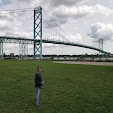
Down on the lower Potomac River south of Washington, D.C.
and near the Chesapeake Bay, an internationally-renowned contracting team is
building the next large-scale bridge project in the state’s history. The
existing Nice/Middleton Bridge (officially the “Governor
Harry W. Nice Memorial/Senator Thomas "Mac" Middleton Bridge”) carrying
U.S. Route 301 across the Potomac between Newburg, MD and Dahlgren, VA is being
replaced with a new structure intended to better serve the high traffic demands
of the present and future.
The name of this bridge has changed multiple times over the years. When it was dedicated in 1940, it was known simply as the Potomac River Bridge (a name folks still use to describe it, even today). In 1967, the bridge was renamed in honor of Harry W. Nice, who served as Governor of Maryland from 1935-39 and was instrumental in approving the funding necessary to build the bridge. In 2018, the bridge's name was modified once again to honor Thomas Middleton, who served as a State Senator in the Maryland Legislature from 1995-2019, representing the state's 28th district in southern Charles County, where the bridge is located.
 Above: The old Nice/Middleton Bridge (photographed here in 2015) was completed in 1940 and is a vital traffic artery along the US Route 301 corridor east of Washington, D.C.
Above: The old Nice/Middleton Bridge (photographed here in 2015) was completed in 1940 and is a vital traffic artery along the US Route 301 corridor east of Washington, D.C.
Below: The old Nice/Middleton Bridge (photographed here in 2015) features narrow roadways and no shoulders, sometimes making for a intimidating experience for drivers.

Under the guidance of the Maryland Transportation Authority (MdTA) and Virginia Department of Transportation (VDOT), a $463 million design-build contract was awarded to the contracting joint venture team of Skanska-Corman-McLean (SCM). Since Maryland owns all of the Potomac River up to the low tide line on the Virginia shore, that agency is responsible for nearly all costs associated with the project. (Virginia has supplied a relatively small amount of funding for the improved US Route 301 approach roads in Dahlgren.) The scope of the project is highlighted by the replacement of the existing bridge with a new four-lane bridge, designed to improve traffic flow and overall safety across the Potomac. Unlike the existing bridge, which does not have any barriers separating oncoming traffic, a concrete median divider will be built along with the new bridge’s deck. The new bridge’s four lane deck will accommodate the ever-increasing traffic demands of the 301 corridor while also providing a bit more margin for error for drivers as opposed to the existing bridge’s narrow roadway.

 Above: The existing Nice/Middleton Bridge stands guard as its replacement takes shape a short distance upstream.
Above: The existing Nice/Middleton Bridge stands guard as its replacement takes shape a short distance upstream.
Below: The new Nice/Middleton Bridge nears completion in these June 2022 photosConstruction of the bridge began in July 2020 and it is expected to be opened in early 2023. Upon completion of the new structure, the old bridge will be closed and demolished. Pieces of the old bridge's concrete and steel superstructure will be recycled for use in the creation of new artificial reefs around the lower Chesapeake Bay nearby.
The following pictures of the existing Nice/Middleton Bridge were taken by the author of this post. Click on each photo to see a larger version.
The
following pictures of the construction site were taken by the author of this post using a DJI quadcopter
drone. Always use proper judgment and situational awareness when flying in
areas such as this. Click on each photo to see a larger version.
How to Get There:













































Comments